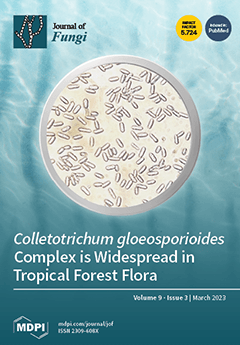Mycoremediation is one of the most attractive, eco-friendly, and sustainable methods to mitigate the toxic effects of heavy metals. This study aimed to determine the mycoremediation capacity of metallophilic fungi isolated from heavy-metal-contaminated soil containing a high Fe(III) concentration (118.40 mg/kg). Four common
[...] Read more.
Mycoremediation is one of the most attractive, eco-friendly, and sustainable methods to mitigate the toxic effects of heavy metals. This study aimed to determine the mycoremediation capacity of metallophilic fungi isolated from heavy-metal-contaminated soil containing a high Fe(III) concentration (118.40 mg/kg). Four common fungal strains were isolated, including
Curvularia lunata,
Fusarium equiseti,
Penicillium pinophilum, and
Trichoderma harzianum. These fungal strains were exposed to gradually increasing concentrations of Fe(III) of 100, 200, 300, 400, 500, 600, 700, 800, 900, and 1000 mg/L. Sophisticated techniques and tests were employed to investigate the mycoremediation capability, including tolerance index (TI), scanning electron microscopy (SEM), Fourier-transform infrared spectroscopy (FTIR), and adsorption isotherm. Furthermore, the impacts of initial concentration, pH, and temperature on the Fe(III) removal (%) and uptake capacity (mg/g) of the studied samples were investigated. The results were validated by statistical analysis using one-way ANOVA. It was found that the Fe(III) uptake with different ratios triggered alterations in the Fe(III) tolerance (TI) morphological (SEM), chemical (FTIR), and adsorption capacity properties. The highest Fe(III) tolerance for all studied fungal strains was achieved at 100 mg/L. Moreover, the optimum conditions of Fe(III) removal (%) for all studied fungal strains were within pH 7 and 28 °C, with similar performance at the initial Fe(III) concentration ranging from 50–200 mg/L. At the same time, the maximum Fe(III) uptake was achieved at pH 7, 20 °C, and 200 mg/L. Compared to other strains, the Fe(III) tolerance of
T. harzianum was rise in the Fe(III) concentration. The Fe(III) uptake reaction was corroborated by best fitting with the Langmuir model, achieving optimum adsorption capacities of 61.34, 62.90, 63.30, and 72.46 mg/g for
C.lunata,
F. equiseti,
P. pinophilum,
T. harzianum, respectively. It can be deduced that the addressed fungi species can be applied in mycoremediation according to the utilized Fe(III) concentrations with more superiority for live
T. harzianum.
Full article






